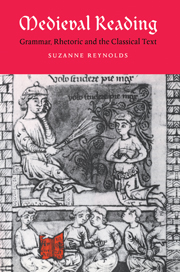Book contents
- Frontmatter
- Contents
- Acknowledgments
- Abbreviations
- 1 Introduction
- Part I CONTEXTS FOR READING
- Part II READING PRACTICE
- 4 Origins and mythologies: the invention of language and meaning
- 5 Reading word by word 1: the role of the vernacular
- 6 Reading word by word 2: grammatical and rhetorical approaches
- 7 From words to the phrase: the problem of syntax
- 8 Government: the theory and practice of a grammatical concept
- 9 Rival orders of syntax: vernacular, natural and artificial
- 10 From the phrase to the text: grammatical and rhetorical approaches again
- 11 Naked intention: satire and a new kind of literal reading
- 12 Literacy: a new model for the classical text in the Middle Ages?
- Notes
- Select bibliography
- General index
- Index of manuscripts
- Cambridge Studies in Medieval Literature
5 - Reading word by word 1: the role of the vernacular
from Part II - READING PRACTICE
Published online by Cambridge University Press: 22 September 2009
- Frontmatter
- Contents
- Acknowledgments
- Abbreviations
- 1 Introduction
- Part I CONTEXTS FOR READING
- Part II READING PRACTICE
- 4 Origins and mythologies: the invention of language and meaning
- 5 Reading word by word 1: the role of the vernacular
- 6 Reading word by word 2: grammatical and rhetorical approaches
- 7 From words to the phrase: the problem of syntax
- 8 Government: the theory and practice of a grammatical concept
- 9 Rival orders of syntax: vernacular, natural and artificial
- 10 From the phrase to the text: grammatical and rhetorical approaches again
- 11 Naked intention: satire and a new kind of literal reading
- 12 Literacy: a new model for the classical text in the Middle Ages?
- Notes
- Select bibliography
- General index
- Index of manuscripts
- Cambridge Studies in Medieval Literature
Summary
Adelard of Bath's personified Grammatica is the means by which the Latin language is brought under control and made susceptible to human analysis. Indeed, in this and many other twelfth- and thirteenth-century accounts, Latin and grammatica are virtually synonymous. Both are characterised by ideas of order, analogy and system; there are rules to be observed. In stark contrast, the vernaculars of France and England in particular were a site of disorder, with French and English not only changing in both their spoken and written forms, but in some cases competing against each other for cultural primacy. Neither had at this point what we might term a written grammatical ‘constitution’, and both form part of a linguistic map that Michael Clanchy has called ‘extraordinarily complex’. Indeed, one of the most important cultural productions of this period attests to this complexity in a very striking way. The Eadwine Psalter, named after its Canterbury scribe and recently and securely assigned by the late Margaret Gibson to a mid-twelfth century date (1155–1160), articulates visually the complex interrelationships of Latin and vernaculars in England a century after the Norman Conquest. The manuscript contains in parallel columns the three Latin versions of the Psalms; the Gallican in the outer column, with the Hebrew and Roman Psalters alongside on each page. The so-called Hebrew Psalter is glossed with Anglo-Norman, to form ‘a convenient translation in the current vernacular of status’.
- Type
- Chapter
- Information
- Medieval ReadingGrammar, Rhetoric and the Classical Text, pp. 61 - 72Publisher: Cambridge University PressPrint publication year: 1996



